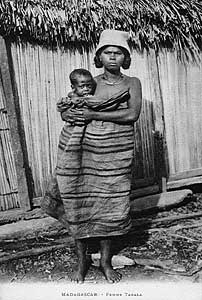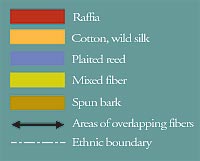
Cloth in Madagascar is not just worn: it is displayed. The lamba, or woven textile, is anything but stiff fabric or a static form. It is meant to be worn and, as clothing, offers the wearer opportunities for individuality and self-expression. The lamba was and remains today a symbol of identity, social rank, wealth, age and ethnicity.
The symbolic meaning of a cloth is read in its design, size, color, decoration, fiber and the way it is arranged on the body. Pulled over the head, it protects against cold weather or expresses shyness. Wrapped tightly around the body, it shows action and determination. Draped over the shoulder, it conveys messages to an admirer or illustrates a flair for fashion.
 The plaited-reed dress and boxy constructed jacket and hat from Madagascar are more than 80 years old, but they have a contemporary look in their elegant simplicity and inspired use of natural fibers. For centuries, reed clothing was the speciality of the Antemoro, Tanala, Tesaka, Tefasy and Tanosy peoples of Madagascar's southeast coast.
The plaited-reed dress and boxy constructed jacket and hat from Madagascar are more than 80 years old, but they have a contemporary look in their elegant simplicity and inspired use of natural fibers. For centuries, reed clothing was the speciality of the Antemoro, Tanala, Tesaka, Tefasy and Tanosy peoples of Madagascar's southeast coast.
Women did not create reed clothing on the loom but fashioned it from plaited and joined mats made of harefo reeds. Delicate, supple clothing was the result of skillful plaiting. Repeated wearing further softened the fibers,
and rainwater was said to make the plaited fibers more waterproof.

 Along
Madagascar's southeastern coast, 19th-century women's attire consisted of
three plaited mats stitched together to form a tube, which was belted or
pulled up around the chest. Young girls reaching puberty also wore brassieres
of soft and finely plaited reeds. Men wore plaited-reed tunics or tailored
jackets, which, softened with wear, provided comfortable protection from
the elements while the men worked in the fields. Both men and women wore
boxy plaited-reed hats accented with colorful yarn embroidery. Along
Madagascar's southeastern coast, 19th-century women's attire consisted of
three plaited mats stitched together to form a tube, which was belted or
pulled up around the chest. Young girls reaching puberty also wore brassieres
of soft and finely plaited reeds. Men wore plaited-reed tunics or tailored
jackets, which, softened with wear, provided comfortable protection from
the elements while the men worked in the fields. Both men and women wore
boxy plaited-reed hats accented with colorful yarn embroidery.
Today, commercial cloth wrappers and Western-style manufactured clothing
are preferred in the region and have largely replaced reed fashions of
a century ago. Plaited-reed hats, however, are still very popular, and
men continue to wear reed jackets for their work in the forests and rice
fields, thus continuing this distinctive fabric tradition in Madagascar.

 The
brilliant, colorful cloth shown is made from tree bark and testifies to
the extraordinary skills of Malagasy weavers. The Zafimaniry and Betsileo
women of the forested southeast laboriously transformed the inner bark of
several species of trees into a fine, durable yarn. They dyed it with natural
and chemical pigments and tightly wove it into cloths used as ceremonial
wear and to wrap the deceased for burial. Spun bark cloth is still produced
today, especially for men's work shirts, though it is becoming quite rare. The
brilliant, colorful cloth shown is made from tree bark and testifies to
the extraordinary skills of Malagasy weavers. The Zafimaniry and Betsileo
women of the forested southeast laboriously transformed the inner bark of
several species of trees into a fine, durable yarn. They dyed it with natural
and chemical pigments and tightly wove it into cloths used as ceremonial
wear and to wrap the deceased for burial. Spun bark cloth is still produced
today, especially for men's work shirts, though it is becoming quite rare.
 Fibers are
Fibers are
- stripped from the inner bark of certain trees;
- boiled for many hours;
- scrubbed on a large rock by the river;
- dried in the sun;
- split and knotted end-to-end;
- rolled on the thigh to provide twist;
- dyed with natural and chemical pigments;
- woven into cloth;
- beaten with a mallet to soften and add sheen.

 Early
postcards from Madagascar document the importance of cloth worn for everyday
and ceremonial occasions and the blending of Malagasy and either Western
or Swahili (coastal East Africa) clothing styles at the end of the 19th
century. While the publishers issuing the postcards were often listed, the
names of the photographers unfortunately were not, although Malagasy photographers
were active by the early part of the 20th century. Early
postcards from Madagascar document the importance of cloth worn for everyday
and ceremonial occasions and the blending of Malagasy and either Western
or Swahili (coastal East Africa) clothing styles at the end of the 19th
century. While the publishers issuing the postcards were often listed, the
names of the photographers unfortunately were not, although Malagasy photographers
were active by the early part of the 20th century.

 This
raffia cloth is distinguished by a striking dye technique called ikat
that is used by weavers in many parts of the world. In Madagascar, ikat
was limited to the Sakalava peoples on the northwestern coast, where it
was called laimasaka (cooked tapestry). Ikat-designed textiles
were destined not for clothing, but for various types of drapery such
as room dividers, tents, mosquito nets, burial shrouds and Islamic prayer
rugs. Such items may have played important roles in royal rituals of Sakalava
kingdoms, but little is known of the meanings or precise use of Madagascar's
ikat cloth, which had largely disappeared by 1925. This
raffia cloth is distinguished by a striking dye technique called ikat
that is used by weavers in many parts of the world. In Madagascar, ikat
was limited to the Sakalava peoples on the northwestern coast, where it
was called laimasaka (cooked tapestry). Ikat-designed textiles
were destined not for clothing, but for various types of drapery such
as room dividers, tents, mosquito nets, burial shrouds and Islamic prayer
rugs. Such items may have played important roles in royal rituals of Sakalava
kingdoms, but little is known of the meanings or precise use of Madagascar's
ikat cloth, which had largely disappeared by 1925.

 Ikat technique involves laying out the warp (the threads that run lengthwise in a fabric), tightly binding the area to be left undyed, and then running the warp fibers through a series of dye baths. When woven, the undyed areas create the designs. Some of the more popular designs depicted humans, cattle and crocodiles. Ikat technique involves laying out the warp (the threads that run lengthwise in a fabric), tightly binding the area to be left undyed, and then running the warp fibers through a series of dye baths. When woven, the undyed areas create the designs. Some of the more popular designs depicted humans, cattle and crocodiles.

 Raffia, a fiber obtained from the leaf of the raffia palm, was the primary textile fiber for peoples living in the entire northeastern half of the island of Madagascar. Women along the east coast made short raffia wrappers for themselves and smocks for their husbands. Characteristic striped designs were achieved by weaving fibers dyed with natural and chemical pigments. Raffia, a fiber obtained from the leaf of the raffia palm, was the primary textile fiber for peoples living in the entire northeastern half of the island of Madagascar. Women along the east coast made short raffia wrappers for themselves and smocks for their husbands. Characteristic striped designs were achieved by weaving fibers dyed with natural and chemical pigments.Sakalava women also wove ikat-designed panels that were used for Islamic prayer rugs. Impressively large panels were sewn together to form mosquito nets and tents.
Raffia textiles remain popular in Madagascar, where they continue to be used for wrappers, tailored clothing and as fashion accessories, such as hats and handbags.

Preparing raffia fiber for weaving is arduous work for women, who
- select and cut tender palm leaves;
- scrape and cut leaves lengthwise and comb it into fine strips;
- knot meter-long strips end-to-end to create a continuous yarn;
- dye threads with natural and chemical pigments and weave them.
Pictured above (from top to bottom)
Two fashionable Tanosy women from southeastern Madagascar wearing plaited-reed dresses and brassieres and wide leather belts
Photographer unknown, c. 1895
From Voyage à Madagascar (1889-1890) by Louis Catat (Paris: Administration de l'Univers, c. 1891)
Courtesy Smithsonian Institution Libraries, African Art Branch
Zafimaniry women sporting reed hats and cloth wrappers woven from bark or raffia fiber
Photographer unknown, c. 1900
Collotype
Postcard Collection, MG-20-45
Eliot Elisofon Photographic Archives
National Museum of African Art, Smithsonian Institution
Indigenous group in Swahili or Zanzaari-style dress, Antsiranana
Photographer unknown, c. 1900
Collotype
Postcard Collection, MG-20-10
Eliot Elisofon Photographic Archives
National Museum of African Art, Smithsonian Institution
Raffia ikat panel (laimasaka)
Sakalava peoples, Kandreho region, Madagascar
Mid-20th century
Raffia fiber, dye
Photograph by Iariliva Rajaonarivelo
Institut de Civilisations, Musée d'Art et d'Archaéologie, Madagascar, 72-2-32
Sakalava women weaving an undyed raffia textile
Photographer unknown, c. 1900
Collotype
Postcard Collection, MG-4-8
Eliot Elisofon Photographic Archives
National Museum of African Art, Smithsonian Institution
Tanala mother and child wearing striped raffia cloth
Photographer unknown, c. 1900
Collotype
Postcard Collection, MG-20-36
Eliot Elisofon Photographic Archives
National Museum of African Art, Smithsonian Institution
|
